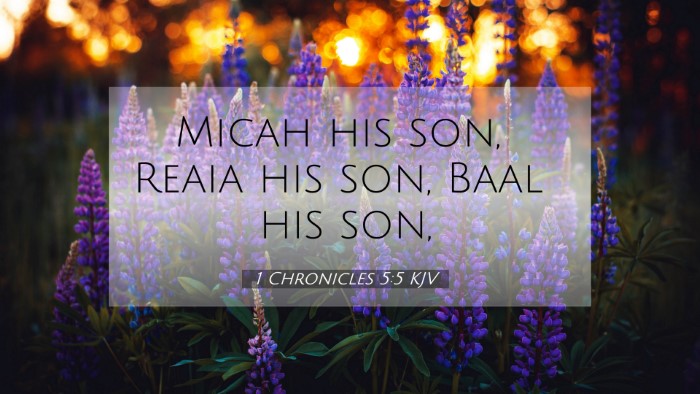Understanding 1 Chronicles 5:5
Verse: "And the sons of Joel were Shemaiah his son, and the sons of Gid, the son of Levi, Joram." - 1 Chronicles 5:5
Summary of 1 Chronicles 5:5
This verse provides a genealogical record focusing on the descendants of Joel and Gid, two significant figures in the tribe of Levi. It emphasizes the importance of lineage and the preservation of family heritage in the biblical context.
Commentary Insights
Below are combined insights from respected public domain commentaries:
-
Matthew Henry:
Matthew Henry highlights the significance of genealogy in Scripture as a way to affirm God's promises to specific families and tribes. He reflects on the Levi tribe's dedicated service to the temple and how this lineage is crucial for maintaining the priestly order.
-
Albert Barnes:
Barnes focuses on the role of Joel and Gid, noting that their genealogies serve to connect the history of Israel's leadership and priestly service. He suggests that the record serves not just historical purposes but also theological ones, indicating divine order through the family line.
-
Adam Clarke:
Adam Clarke elaborates on the individuals mentioned, asserting that understanding the family tree of Levi enriches our comprehension of the Old Testament priesthood. He points out the continuity of these lines and how they contribute to the Israelites’ religious practices and national identity.
Cross References
The following Bible verses relate to 1 Chronicles 5:5, enriching our understanding through connections and parallels:
- Exodus 6:16-25: A genealogical account of the Levites, providing background on the Levitical heritage.
- 1 Chronicles 6:1-5: Further genealogy of Levi, emphasizing the significance of each tribe's descendants.
- Numbers 3:17-39: Details on the Levitical families, establishing their roles within the Israelite community.
- Hebrews 7:14: Points to the importance of priestly lineage in understanding Jesus' role, presenting a comparison between the Levitical priesthood and Christ's eternal priesthood.
- Malachi 2:4-6: Speaks about the covenant with Levi, shedding light on the responsibilities associated with the Levitical lineage.
- Luke 3:23-38: The genealogy of Jesus, showcasing connections to the Jewish faith and the significance of lineage in His identity.
- Matthew 1:1-17: A detailed genealogy of Jesus that traces back through significant figures, including those from the line of Levi.
Thematic Connections
1 Chronicles 5:5 can be connected to broader biblical themes of:
- Heritage and identity within God's chosen people.
- The continuity of God's covenantal promises through generations.
- The role of priests and Levites in mediating the relationship between God and His people.
Using Biblical Cross-References
Engaging in cross-referencing Bible verses like 1 Chronicles 5:5 serves as a powerful tool for deeper understanding. Here are some tips on how to do this effectively:
- Locate Patterns: Look for recurring names and themes across genealogies to find connections.
- Thematic Studies: Focus on specific themes such as priesthood, covenant, and lineage across both Old and New Testaments.
- Tools for Bible Cross-Referencing: Utilize resources like Bible concordances and thematic study guides.
Conclusion
In summary, 1 Chronicles 5:5 may seem like a simple genealogical record, yet it opens up pathways to rich theological insights and connections across Scripture. By studying biblical genealogies and engaging in systematic cross-referencing, believers can gain a deeper understanding of God’s unfolding story through His people.


